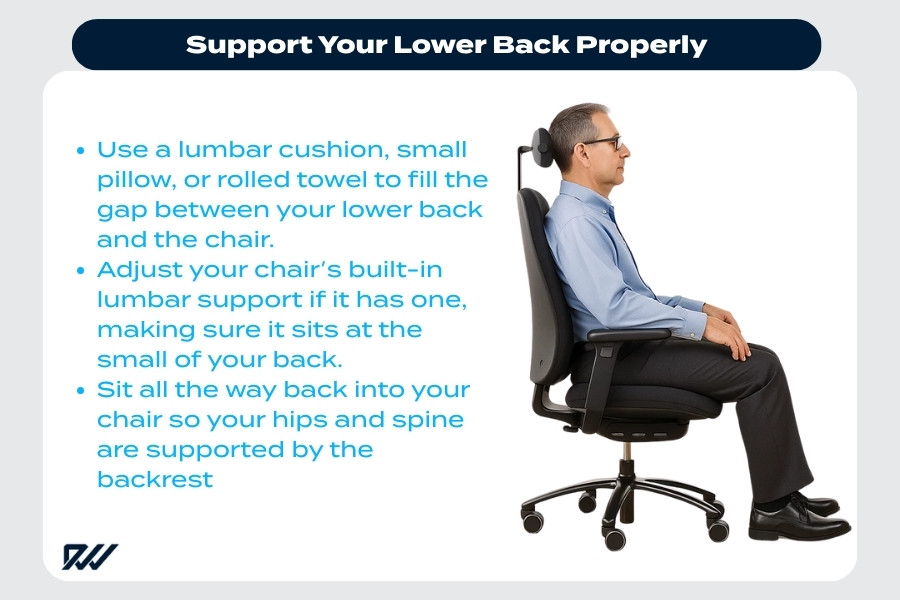Desk Job? Here’s How to Protect Your Lower Back While Sitting All Day
Sitting at a desk for hours can take a serious toll on your lower back. Prolonged sitting compresses spinal discs, weakens core muscles, and leads to stiffness and chronic pain. Millions of office workers experience discomfort daily, yet many don’t realize that small adjustments and targeted strategies can prevent long-term damage. In this guide, we’ll explore practical ways to protect your lower back while sitting all day, backed by science and expert recommendations. Desk Job? Here’s How to Protect Your Lower Back While Sitting All Day
Why Desk Jobs Are Hard on Your Lower Back
Modern office work often involves extended periods of sitting, sometimes with poor posture or ergonomics. Over time, these habits can cause:

1. Spinal Compression
Sitting places extra pressure on the lumbar discs compared to standing. Over long periods, this can contribute to disc degeneration and pain.
2. Muscle Weakness
Inactive core and glute muscles lose strength, reducing support for the spine. Weak muscles increase the risk of strain, injury, and chronic pain.
3. Poor Posture
Slouching, leaning forward, or hunching over a computer keyboard alters spinal alignment, leading to tightness, soreness, and long-term postural issues.
How to Protect Your Lower Back While Sitting
Preventing lower back pain while working at a desk requires a combination of proper posture, ergonomic setup, movement, and strengthening exercises.
1. Optimize Your Desk Setup
Your workspace should support neutral spine alignment to reduce stress on the lumbar region.
- Chair: Choose an ergonomic chair with lumbar support that maintains the natural curve of your lower back.
- Desk Height: Your elbows should rest comfortably at a 90-degree angle when typing.
- Monitor Position: Keep your monitor at eye level to avoid craning your neck forward.
- Foot Placement: Keep both feet flat on the floor or on a footrest to maintain hip alignment.
2. Maintain Proper Sitting Posture
Even with the right equipment, posture is key. Follow these tips to protect your lower back:
- Sit Upright: Keep shoulders relaxed and back straight, avoiding slouching.
- Engage Your Core: Lightly tighten your abdominal muscles to support the spine.
- Keep Knees and Hips at 90 Degrees: Avoid crossing legs for long periods, which can misalign the pelvis.
3. Take Frequent Movement Breaks
Even perfect posture can’t prevent the negative effects of prolonged sitting. Movement is essential to reduce spinal compression and improve circulation.
- Stand Up Regularly: Take a 1–2 minute break every 30–60 minutes to walk, stretch, or perform light exercises.
- Micro-Movements: Gentle torso twists, shoulder rolls, and seated marches keep muscles engaged.
- Set Reminders: Use a timer or apps to remind you to move.
4. Incorporate Desk-Friendly Stretches
Stretching throughout the day helps relieve tension in the lower back, hips, and hamstrings.
- Seated Spinal Twist: Sit upright, place your right hand on the back of your chair, twist gently to the right, and hold for 20 seconds. Repeat on the left.
- Hip Flexor Stretch: Stand up, step one foot back, and gently press your hips forward to stretch the hip flexors.
- Hamstring Stretch: Extend one leg forward, hinge at the hips, and reach toward your toes while keeping your back straight.
5. Strengthen Core and Back Muscles
Strong muscles provide spinal support and reduce strain from prolonged sitting.
- Planks: Hold a plank position for 20–60 seconds to engage your entire core.
- Bridges: Lie on your back with knees bent, lift your hips, and squeeze your glutes to strengthen the posterior chain.
- Bird-Dog: On all fours, extend opposite arm and leg, maintaining a neutral spine. Repeat on both sides.
6. Use Ergonomic Accessories
Small adjustments can significantly reduce lower back strain.
- Lumbar Cushions: Add extra support for the lower spine if your chair lacks it.
- Standing Desk or Desk Converter: Alternate between sitting and standing to relieve spinal compression.
- Keyboard and Mouse Position: Keep tools within easy reach to prevent leaning or twisting.
Lifestyle Habits to Support a Healthy Back
In addition to desk-specific strategies, general lifestyle habits play a major role in protecting your lower back.
1. Stay Active Outside Work
Regular exercise, such as walking, swimming, or yoga, improves circulation, strengthens muscles, and reduces stiffness.
2. Maintain a Healthy Weight
Excess body weight places additional stress on the lumbar spine. Balanced nutrition and physical activity help reduce this burden.
3. Manage Stress
Stress can cause muscle tension, especially in the back and shoulders. Techniques like deep breathing, meditation, or stretching can alleviate this tension.
4. Prioritize Quality Sleep
Sleep on a supportive mattress with proper alignment for your spine. Consider a pillow under the knees (back sleepers) or between the knees (side sleepers).
Conclusion
Working a desk job doesn’t have to mean chronic lower back pain. By optimizing your workspace, maintaining proper posture, incorporating movement and stretches, and strengthening supporting muscles, you can protect your spine and reduce discomfort. Combined with healthy lifestyle habits, these strategies will keep your lower back pain-free, even during long hours at the desk. Small, consistent changes are the key to long-term spinal health and a more comfortable workday.


